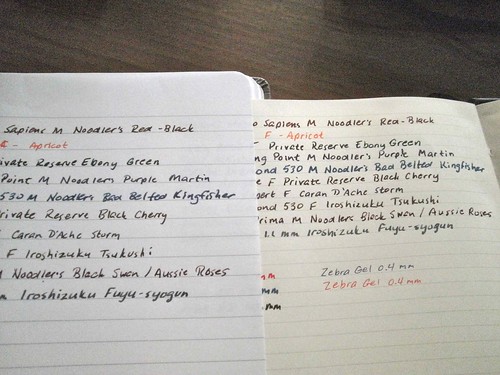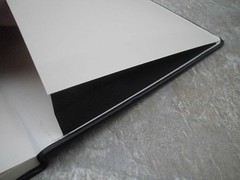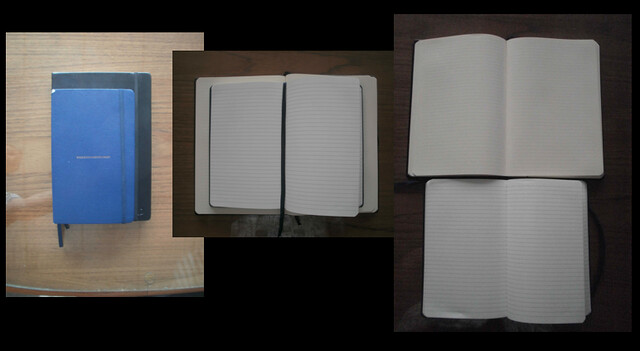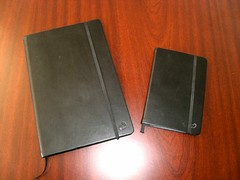 UPDATE: Giveaway Entries are Closed. Winners will be posted and contacted on June 30.
UPDATE: Giveaway Entries are Closed. Winners will be posted and contacted on June 30.This is "version 2.0" of the Habana that I reviewed here. All the great quality remains, but fans of the old Habana need to be aware of changes in the color, ruling, and weight of the paper.
Instructions for entering the giveaway are at the end of this post, and there's even a consolation prize!
The Review
The old and new versions both have 80 sheets of Clairefontaine's legendary paper. As always, it is silky smooth to the touch and a dream to write on. So smooth, in fact, that I've read complaints from some Fountain Pen Network members that the paper is too smooth and makes them lose control of their pen! I love the smooth writing feel, but there is a price to pay for it: ink drying times tend to be slow. If you write with a fountain pen, you're going to wind up with lots of ink transfer to the opposite page unless you give time for the ink to dry (which could be 30 seconds or more, depending on the ink and nib combination) before closing the notebook or you use a sheet of blotting paper as a bookmark.
But the paper is otherwise quite different from the original version of the Habana:
Original U.S. Version
|
New Version
(reviewed in this post)
|
|
Paper Weight
|
90 gsm
|
85 gsm
|
Paper Color
|
bright white
|
ivory
|
Ruling width
|
8 mm
|
5.5 mm
|
Lines per page
|
26
|
40
|
Distance from top of page to first rule
|
24 mm
|
9 mm
|
Distance from bottom of page to last rule
|
14 mm
|
9 mm
|
Rules
|
light gray solid lines
|
light gray dotted lines
|
Unfortunately, none of my photos accurately captured the color of the pages. The closest would probably be this one. When you see "ivory," you shouldn't confuse it with "off-white." I've seen this paper described as "off-white," but the paper is far darker than that. From what I can tell, it is about the same color as the paper in my Rhodia webnotebook.
The 5.5 mm ruling is very narrow. People who typically write with finer points and tend to write small anyway will love it. But if you like to write big and bold, this notebook probably only makes sense for you if you're going to write on every other line. Large writing would bunch lines much too closely to read comfortably. Fans of the old ruled Habana are going to have a hard time adjusting to this one.
 |
| What a difference in ruling! Old version on left, new version on right. Top-most group of lines on rights is same as number of lines on left. |
Another nice plus to the changes is that between the color of the paper and the dotted lines, the the light gray dotted rules are virtually unnoticeable on the written page. There's just enough there to guide your writing as you go, and it is almost invisible once you've written on it.
Another change in the ruling is that unlike the older version, the ruling does not extend the entire width of the page from the binding to the edge. Instead, there is a border of "white space" a few mm wide at both the binding and page edge.
The paper in this generation of Habana is a slightly lighter weight than in the first generation U.S. version. This apparently was a compromise between the weight in the U.S. version and non-U.S. version of the first generation Habana so that a single version of the second-generation Habana could ship everywhere.
The lighter weight is not really noticeable to the touch, nor does it result in a noticeably thinner notebook, but the lighter paper did allow some ever-so-slight and occasional bleed-through with two of the fountain pen inks I tried. Show-through actually seemed about the same or slightly better on the lighter ivory paper than on the heavier white paper of the first generation, probably on account of the color. Needle-point pens seemed to leave a significantly deeper impression in the lighter paper (though I can't guarantee I wrote with the same pressure in both versions, so this observation may be a result of writing with different pressure in each notebook). A light touch may be needed with those pens to keep from introducing too much texture to the reverse side of the page. There was no noticeable feathering with any of the fountain pen, gel, or rollerball inks I tried.
 |
| Sturdy, fabric-like gusset on the large back pocket suggests durability |
Which is a good thing, because this pocket will see more use if I use a Habana for work. Because the dimensions of the large Habana (6.25 in x 9.25 in.) are larger than the typical A5-sized notebook, it will accommodate a letter-size sheet folded in half, which the pockets of A5-size notebooks simply can't.
 |
| Three views comparing the large Habana to a typical "large" notebook. The smaller notebook I used here, however, is about 1/4 inch narrower (when closed) than a large Moleskine. |
The Giveaway
 |
| Left: New version large Habana. Right: Old version pocket Habana. |
To enter, do BOTH of the following:
1. Leave a comment on this post, AND;
2. Email me at notebookeresqATgmail.com. Your email must give the name you used for commenting and the subject line must read EXACTLY:
HABANA
I do it this way to be sure I can contact the winners and so I can set up an email filter to group all entries as they come in. I will keep the giveaway open through at least midnight Pacific time on Tuesday, June 27.
The winner will be selected using the random number generator at random.org.
Good luck!


Nice Review! Looks like a nicely made notebook.
ReplyDeleteGreat review! I love how the new ruling doesn't run all the way to the edge; it looks very clean!
ReplyDeleteI am not sure if I should be happy or sad that I never got to try the first gen. I prefer white to ivory, given the option. As for the spacing, I opt for unlined when possible, but wide trumps college otherwise. At least I never got really attached to the original. It will be interesting to see how well the new product fares overall.
ReplyDeletemillicent
mhjanine@rocketmail.com
Nice review seems like a great notebook. Glad to see a post on the site :)
ReplyDeleteA generous way to pay to forward. It looks like a really nice notebook! I hope I win it! (grin)
ReplyDeleteThank you for the give-away. the review was well done as always.
ReplyDeleteThanks for doing this and for the review! :D
ReplyDeleteI would love to give either of these notebooks a try after such a thorough and well written review!
ReplyDeleteI really appreciate your reviews. Very informative and helpful.
ReplyDeleteGray dots ---> LOVE! :)
ReplyDeleteI would actually prefer to be the runner up, but since I haven't yet tried the NEW version, that would be nice too.
ReplyDeleteSometimes it seems like Moleskines are the only notebooks around (they're so prominent in every stationery store)! This would work great for my tiny handwriting, and the light grey ruling looks very elegant. Thanks for your generosity!
ReplyDeleteThanks for the review! I'm looking for something new for my daily "log book" that I started keeping instead of a planner.
ReplyDeleteI've heard a lot of good things about Quo Vadis Habana notebooks and would love to try one out. Thanks for the giveaway!
ReplyDeleteI've only tried Moleskines, Piccadilly notebooks, and Rhodia notepads. These Habanas look great. Thanks for the chance!
ReplyDeletewell, you managed to get me really interested in the new Habana. i"m always looking for narrow ruling and this seems to fit the bill perfectly!
ReplyDeleteI haven't tried out a Habana yet, but I'd sure like to get my hands on one of these! Thanks for the comparison/review!
ReplyDeleteWould love to get it!
ReplyDeleteI've never tried a Habana, but I've heard so many good things about them that I'd like to.
ReplyDeletePlease note that this is my entry.
ReplyDeleteLooks lovely! Off to email you!
ReplyDeleteI loved the light gray dotted lines over an ivory background! It's hard to find this specific setup that's both elegant and pleasant to write on. Fingers crossed!
ReplyDeleteIt looks so great!
ReplyDeleteI've never tried one of these, but I would very much like to!
ReplyDeleteI really appreciate the thoroughness with which you review each and every product! Please keep doing what you love!
ReplyDeleteThis notebook would be great for travel. It looks sturdy!
ReplyDeleteThose are some nice notebooks. Never tried this brand, but you've given a fair and balanced review that makes me want to take one for a test drive.
ReplyDeleteNice looking notebooks
ReplyDeleteI'd love to try this notebook! I have tiny handwriting so the narrower ruling makes me pretty excited. =)
ReplyDeleteNice notebooks and a nice review. Thank you!
ReplyDeleteThanks for a well rounded review. I like the change to narrower dotted lines and smaller margins, but was sorry to read that there was some bleed through and potential for smudging due to longer drying times. I would love to give it or the consolation prize a spin to see how it does with my xxf nibs and light hand.
ReplyDeleteThis looks awesome. Sign me up!
ReplyDeletejackie
lettersandjournals.com
Looks like a great notebook!
ReplyDeleteThanks for the chance to win... :)
Great review!
ReplyDeletethank you for the review and the giveaway!
ReplyDelete